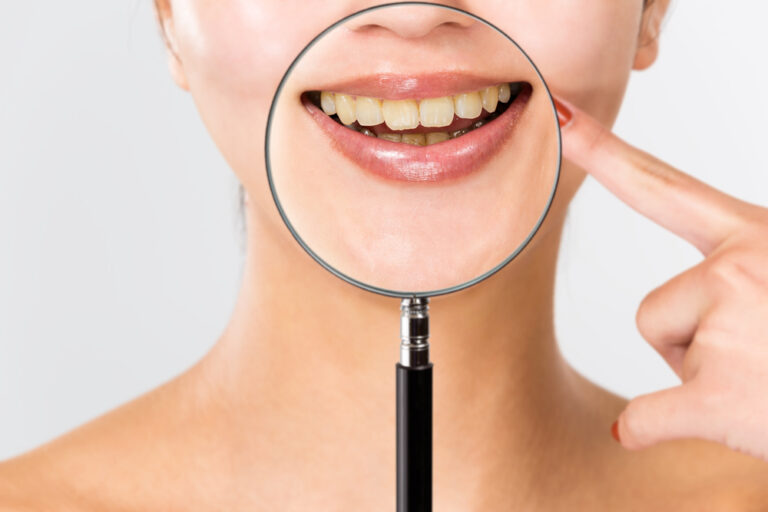Having a smile full of large, protruding teeth can be detrimental to both your appearance and oral health. Abnormally oversized teeth affect the symmetry of your smile, often standing out like sore thumbs among properly sized surrounding teeth. Big teeth not only look unsightly, but they can lead to dental problems like misalignment, impaired chewing, and increased risk of fracture over time. Thankfully, today’s cosmetic dentistry offers various effective options for conservatively reshaping enlarged teeth to improve their size, shape, and proportions.
What Causes Teeth to Be Unusually Large?
To understand how to correct oversized teeth, you first need to understand what caused them to be so large in the first place. There are several potential reasons why one or more of your teeth may have ended up overgrown:
Genetic Predisposition
Some individuals simply inherit teeth that tend to be larger than the norm. Genetics plays a major role in tooth size, so oversized teeth can run in families. Parents with naturally large teeth often pass those traits down to their children. Large teeth may exist symmetrically or be confined only to certain areas like the front incisors or canines.
Developmental Dental Conditions
Certain developmental disorders and conditions can cause teeth to become abnormally large:
- Macrodontia – This condition causes teeth to be substantially larger than average. It may affect multiple teeth or exist in a localized area. The exact cause is unknown but is thought to involve genetic and environmental factors disrupting embryologic dental development.
- Gemination – This anomaly occurs when tooth buds attempt to split into two but only partially divide. The result is a tooth with a wider, overgrown appearance. Gemination typically affects front incisors and premolars.
- Fusion – Fused teeth arise when two developing tooth buds fully merge together into one enlarged, conjoined tooth. The excess width gives the appearance of a single giant tooth. Fusion is also more prevalent in anterior teeth.
- Dentinogenesis Imperfecta – This inherited condition affects dentin development, causing teeth to appear overgrown and amber-hued. Affected teeth also tend to wear down and fracture easily.
Environmental Influences
Research suggests that early childhood health issues, trauma to the jaws, or excess fluoride intake could potentially contribute to larger tooth size as well, though findings remain speculative. Additional studies are needed to fully understand non-genetic influences on tooth overgrowth.
Problems Related to Having Large Teeth

Aside from simply looking unaesthetic, having abnormally bulky teeth can cause a number of oral health and functional issues:
- Poor dental alignment – Having teeth that are too big can make it difficult to achieve proper bite alignment between upper and lower arches. This is especially true when oversized teeth exist alongside normally-proportioned teeth.
- Increased overjet – Protruding upper front teeth result in increased overjet, which is the horizontal overlap of upper teeth relative to the lower teeth. Excess overjet leads to a greater risk of trauma and injury to incisors.
- Crowding and spacing – Big teeth can become crowded or cause widening of spaces between other teeth. This also disrupts ideal dental positioning.
- Jaw misalignment – In some situations, oversized teeth can force the upper and lower jaws out of their natural positions, resulting in a poor bite relationship known as malocclusion.
- Chewing impairment – Misaligned jaws and dental arches make effective chewing of food difficult. Biting ability is also compromised, which could affect nutrition.
- Tooth instability – Having one or more abnormally large teeth decreases overall tooth stability. Oversized teeth become loose more easily and have an increased risk of fracture.
- Damage to bone and gums – Excess pressure placed on the jawbone and gums by extremely large teeth can lead to bone and gum loss over time. This causes sensitivity and increasesDecay is also more likely around insufficient gum tissue.
- Accelerated wear – The additional biting forces generated by large teeth speeds up attrition and wearing down of enamel. Loss of tooth structure in this way increases susceptibility to decay.
- Aesthetic and self-esteem concerns – Uneven, protruding front teeth that dominate your smile can have major negative impacts on your confidence and self-image. Many people feel embarrassed or ashamed about having severely oversized teeth.
Options for Reshaping Enlarged Teeth
The good news is that today’s many advancements in cosmetic and restorative dentistry make it possible to conservatively reduce the size of overly large teeth for a more balanced, symmetrical smile. Here are some of the main approaches:
Dental Bonding
Dental bonding is a quick, non-invasive option for subtly reshaping mildly to moderately enlarged teeth. The dentist applies a putty-like resin material that is molded and sculpted to change the shape, contour, and edges of the tooth. When hardened with a curing light, the resin blend in seamlessly. Bonding is an affordable way to smooth rough edges or bumps on big teeth. However, it isn’t suitable for drastically reducing tooth size.
Enameloplasty
Also known as odontoplasty or tooth contouring, enameloplasty involves carefully removing controlled amounts of enamel from the teeth to change their shape or size. This is achieved using a dental drill and fine-grit diamond burrs. The dentist meticulously sculpts and recontours the natural tooth enamel to reduce bulk and create proper tooth proportions relative to neighboring teeth. Enameloplasty is highly effective for mild to moderate size reduction cases.
Dental Veneers
Dental veneers are semi-permanent, wafer-thin covers that are bonded to the front surface of teeth. Getting custom veneers made from porcelain, ceramic, or composite materials is an excellent option for significantly decreasing the size of grossly enlarged teeth. The dentist first reshapes the underlying tooth structure prior to placing the veneer. Veneers provide drastic improvements in cases where teeth are excessively protrusive or wide.
Orthodontic Tooth Removal
In severe cases, extraction of one or more oversized teeth may be necessary to allow better positioning of the remaining properly-proportioned teeth. The newly created space is then closed orthodontically using braces and/or clear aligners. Once teeth are aligned, improved symmetry and balance between upper and lower arches is achieved.
Full Coverage Crowns
When teeth are extremely overgrown, full coverage dental crowns may be the best approach to reconstruct a natural size and shape. The bulky original tooth is reduced down and an artificial crown is custom-fabricated and placed to cap the entire tooth. Crowns are also utilized when teeth become weakened by size reduction procedures.
Tooth Reshaping Procedure Overview

Regardless of the specific technique used, the general process for reshaping overgrown teeth involves the following steps:
- Examination and diagnosis – The cosmetic dentist will fully examine your teeth and bite to identify problem areas and determine underlying causes of excess tooth size. X-rays and impressions or scans of your teeth will be taken.
- Treatment planning – Next, the dentist will devise a customized treatment plan based on the severity of your case and your desired results. Options will be discussed and a timeline will be mapped out.
- Preparation – During this phase, anything needed prior to reshaping will be done, such as orthodontics to create space or root canals on teeth being crowned.
- Reshaping procedure – The actual process of altering tooth size and shape will take place during one or more appointments. Local anesthetic is administered to maximize comfort.
- Temporary restoration – Following significant reshaping, temporary veneers or crowns may be placed while permanent restorations are being custom-made.
- Final restoration placement – Once fabricated, the permanent veneers, crowns, or other restorations will be seated and bonded into place.
- Follow-up care – After treatment, some sensitivity and soreness is normal. A soft diet may be needed initially. Ongoing dental visits will be required to ensure results are maintained. Excellent oral hygiene is a must.
With today’s many reshaping options, even significantly oversized teeth can be transformed to have a naturally beautiful shape and proportion. Work closely with your cosmetic dentist to determine the ideal treatment plan based on the extent of tooth size reduction you require, as well as your time, comfort, and budgetary constraints.
Frequently Asked Questions
How much does it cost to fix an overgrown tooth?
Costs vary depending on the technique used and number of teeth requiring treatment. Minor bonding may range from $200-$500 per tooth. Veneers typically cost $950-$2,500 per tooth. More complex cases with orthodontics or crowns can cost $5,000 or more overall.
Is enamelplasty painful?
Having your teeth contoured and shaped via enameloplasty should not be painful, thanks to local anesthesia. Some sensitivity to hot and cold is common afterward but usually resolves quickly. Over-the-counter pain relievers can provide relief as needed.
How long does the reshaping process take?
Most minor reshaping with bonding or enameloplasty can be completed in one or two visits. Cases involving orthodontic alignment prior to reshaping may take 12-24 months total. Discuss estimated timeframes with your cosmetic dentist.
Can severely overgrown teeth be saved?
Even severely oversized or protrusive teeth can usually be conservatively reshaped and restored by an experienced cosmetic dentist. A combination of orthodontics, enameloplasty, dental veneers, and sometimes crown lengthening allow for major size reductions while saving the natural tooth structure. However, extractions are occasionally still required.
Do reshaped teeth last?
When done properly, reshaped teeth remain in their improved size and shape permanently. However, dental trauma, extensive wear, or grinding could alter results over time. Avoiding damaging habits and practicing excellent oral hygiene helps maintain longevity of the teeth after reshaping procedures. Regular dental exams are also key for ensuring longevity of results.
Take Control of Your Smile
Having one or more substantially overgrown teeth doesn’t mean you must hide your smile for life. With today’s reshaping dental techniques, significant improvements in tooth size, proportions, and symmetry are possible. If you struggle with the appearance and dental problems caused by severely enlarged teeth, seek out a highly skilled cosmetic dentist in your area. They can assess your situation and advise you on the ideal treatment options to finally achieve the stunning smile you deserve. The first step is to schedule a consultation and formulate your unique smile transformation plan.







